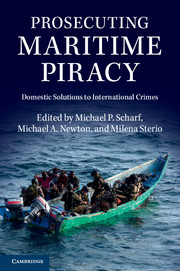Book contents
- Frontmatter
- Contents
- Contributors
- Introduction
- PART I DEFINING THE CRIME OF PIRACY AND ESTABLISHING JURISDICTION OVER THE CRIME OF PIRACY
- 1 The Governing International Law on Maritime Piracy
- 2 The Incorporation of International Law to Define Piracy Crimes, National Laws, and the Definition of Piracy
- 3 Exercising Universal Jurisdiction over Piracy
- 4 Incorporating International Law to Establish Jurisdiction over Piracy Offenses: A Comparative Examination of the Laws of the Netherlands, South Korea, Tanzania, India, and Kenya
- PART II THE PURSUIT, ARREST, AND PRE-TRIAL TREATMENT OF PIRATES
- PART III LEGAL ISSUES IN DOMESTIC PIRATE TRIALS
- PART IV SENTENCING AND POST-SENTENCE TREATMENT OF CONVICTED PIRATES
- Conclusion: Is There a Case for an International Piracy Court?
- Index
2 - The Incorporation of International Law to Define Piracy Crimes, National Laws, and the Definition of Piracy
from PART I - DEFINING THE CRIME OF PIRACY AND ESTABLISHING JURISDICTION OVER THE CRIME OF PIRACY
Published online by Cambridge University Press: 05 June 2015
- Frontmatter
- Contents
- Contributors
- Introduction
- PART I DEFINING THE CRIME OF PIRACY AND ESTABLISHING JURISDICTION OVER THE CRIME OF PIRACY
- 1 The Governing International Law on Maritime Piracy
- 2 The Incorporation of International Law to Define Piracy Crimes, National Laws, and the Definition of Piracy
- 3 Exercising Universal Jurisdiction over Piracy
- 4 Incorporating International Law to Establish Jurisdiction over Piracy Offenses: A Comparative Examination of the Laws of the Netherlands, South Korea, Tanzania, India, and Kenya
- PART II THE PURSUIT, ARREST, AND PRE-TRIAL TREATMENT OF PIRATES
- PART III LEGAL ISSUES IN DOMESTIC PIRATE TRIALS
- PART IV SENTENCING AND POST-SENTENCE TREATMENT OF CONVICTED PIRATES
- Conclusion: Is There a Case for an International Piracy Court?
- Index
Summary
INTRODUCTION
To address the rise in piracy cases over the past several years, many states have been going through a process of incorporating the international laws of piracy, such as the United Nations Convention on the Law of the Sea (UNCLOS) and the Convention for the Suppression of Unlawful Acts against the Safety of Maritime Navigation (SUA Convention) discussed in Chapter 1, into their own domestic criminal law statutes. This chapter compares and contrasts how states have incorporated the international law of piracy into their own domestic legal frameworks and the different approaches states have taken to define piracy in their national courts. Specifically, this chapter examines how the piracy definition has been developed in the United States, the Netherlands, South Korea, Tanzania, Somalia, India, Kenya, the Seychelles, and Mauritius. It then describes how countries such as Japan, the Philippines, and Singapore have used their national antiterrorism laws to address acts of piracy.
INCORPORATING INTERNATIONAL LAW OF PIRACY INTO DOMESTIC LAW
States have taken different approaches to prosecuting pirates on the basis of their own national laws, histories, and interests. Another key factor in their differing approaches may well come from the ways in which the current pirate attacks are occurring. Although some of the basic elements of pirate attacks are similar wherever they occur – for example, pirates generally attack vessels at sea rather than in port, where there is more security and lighting – there are also differences in the current trends that may have implications for legal approaches to combating piracy.
Different Types of Domestic Piracy Require Different Laws
Somali-style piracy, as discussed in Chapter 1, occur mostly on the high seas off of Somalia, with some attacks in the territorial seas and some attacks initiated from land. Lower-level footsoldiers from Somalia generally use smaller ships, utilizing arms and modern GPS systems to take larger vessels by force. They generally raise their money by kidnapping crewmembers for ransom.
- Type
- Chapter
- Information
- Prosecuting Maritime PiracyDomestic Solutions to International Crimes, pp. 32 - 53Publisher: Cambridge University PressPrint publication year: 2015
- 3
- Cited by



